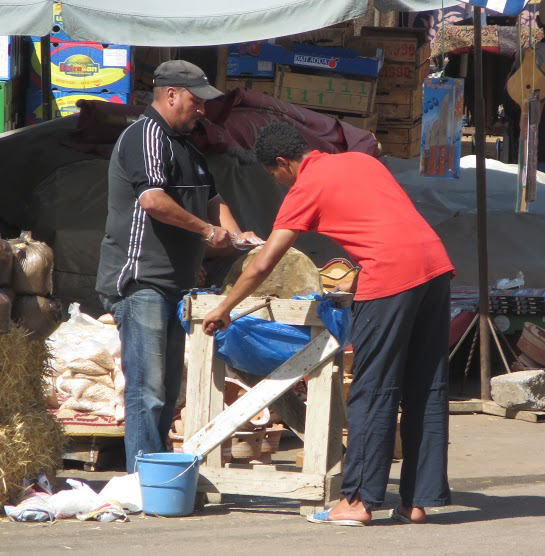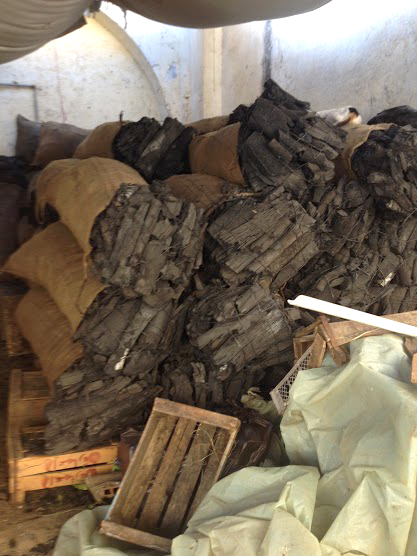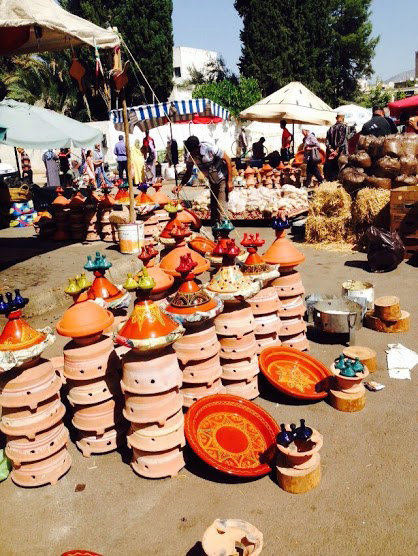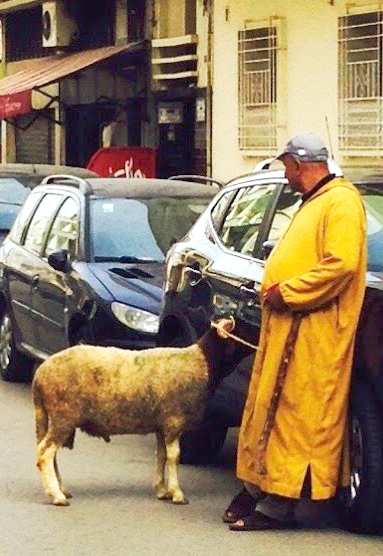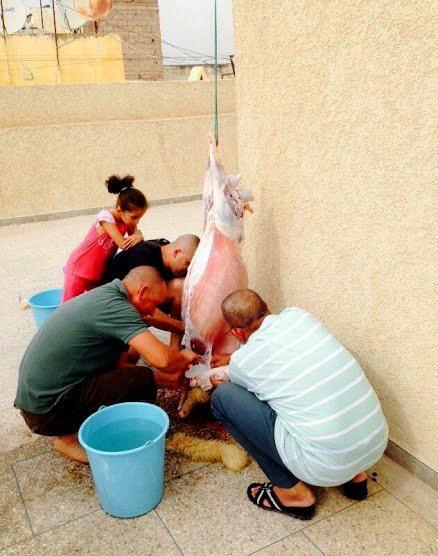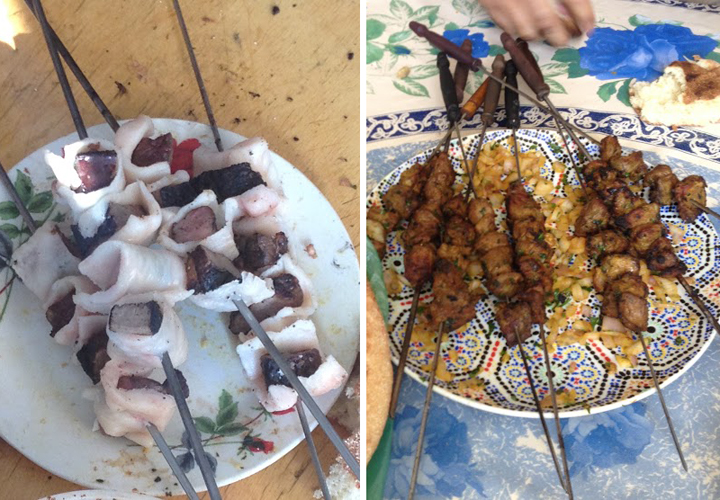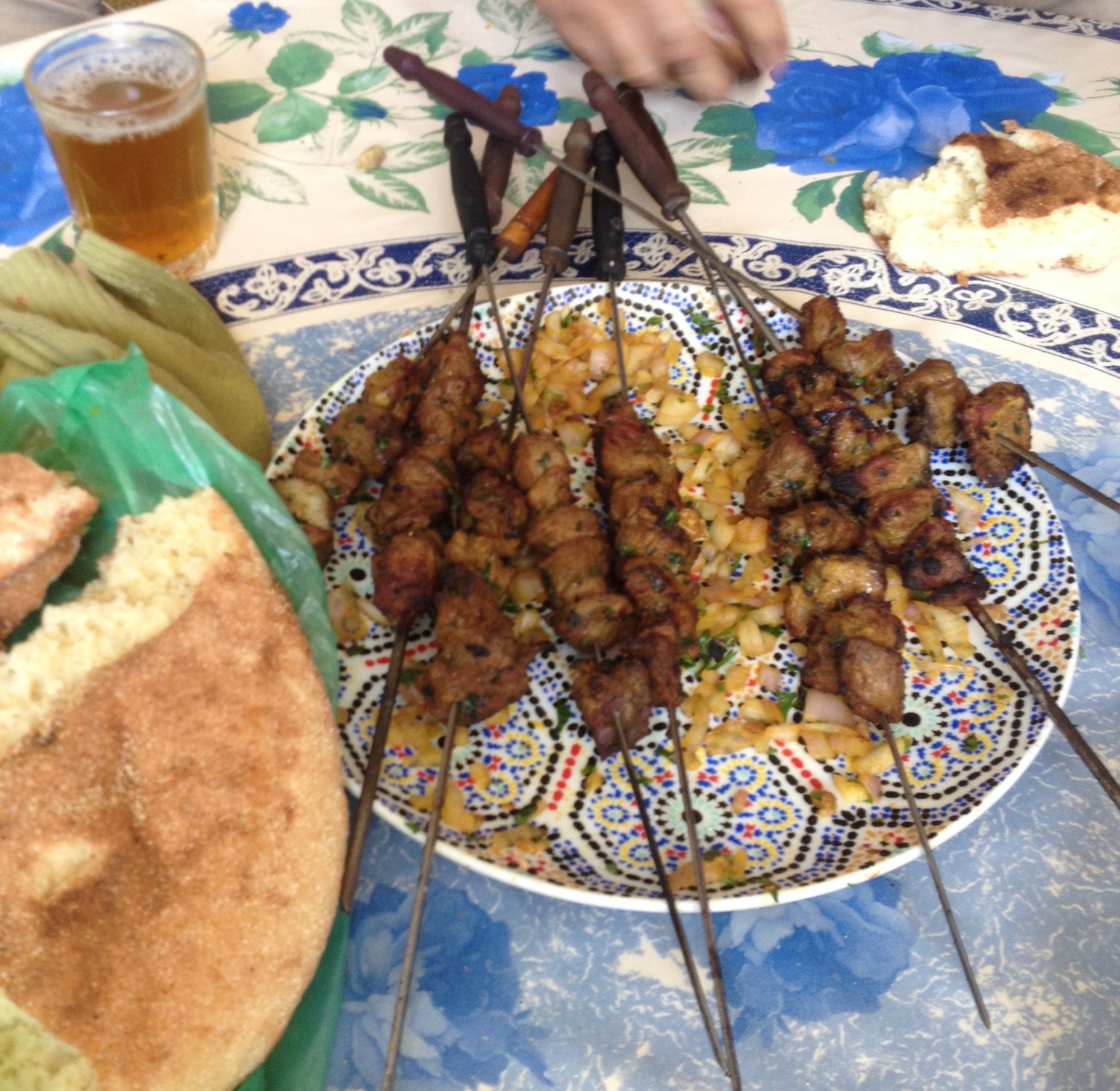
Sensing Eid al Kabir’s Tactile, Viscous Stickiness: Affect, Embodiment and Material Religion
Rebecca Moody reads Eid al Kabir in Fes, Morocco, through the lens of affect theory. The sights, sounds and smells of Eid yield the circulation of “sticky” affect that, as it touches each participant and observer, in turn renders them sticky and therein “(re)surfaces” their material bodies. Moody argues that affect theory offers a unique approach to the study of material religion, specifically Islam, by combining the materiality of the human body with the “textures” of affect that circulate around Islam in its different, quotidian expressions.
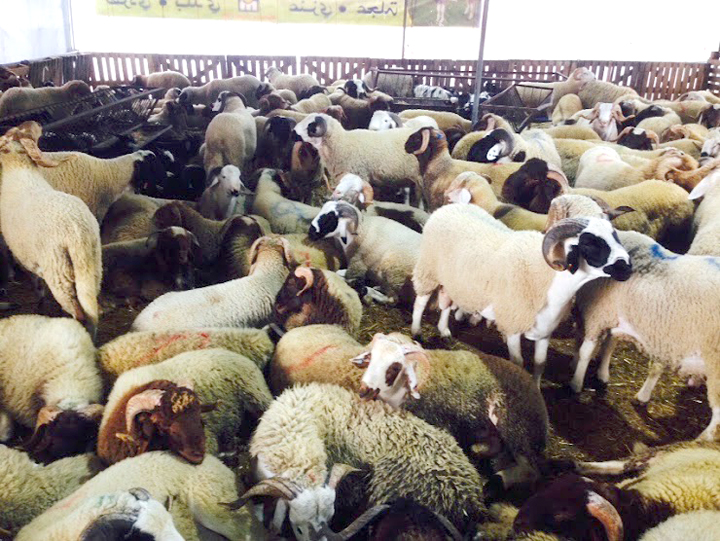
Figure 1: A small sheep souq on the edge of Fes. Photo by author.
Smoke rising in black plumes into the air; the smell of charcoal mingling with the smell of burnt hair and grilled meat. Water flowing in the streets, on sidewalks, down stairs and out doorways; washing away drying blood, it pools in crevices and potholes. Baas and moos - the sounds of sheep and cows - slowly replaced by their silence. The heavy, hot, humid, almost liquid air of a small room in which one has just been slaughtered. Animal skins - the outline of a whole sheep neatly and completely turned inside out - in piles that steadily surpass me in height.
Eid al Kabir is a sensory experience, overwhelming in its affective intensity and material impact. Eid al Kabir, as it’s known in Darija (Moroccan Arabic), translates literally into the big holiday; known in Fus’ha (standard Arabic) as Eid al Adha, the feast of the sacrifice, it corresponds with Eid al Saghir, the little holiday that immediately follows Ramadan. Together, they represent Islam’s two major annual holidays and the only two days of the year when the Prophet Mohammed forbade fasting. Eid al Kabir commemorates Abraham’s willingness to sacrifice his son (in Islam, Ismael; in Judaism and Christianity, Isaac) and Ismael’s willingness to be sacrificed. The Qur’an is very specific about their conversation and about Ismael’s consent:
[W]hen (his son) was old enough to walk with him, (Abraham) said: O my dear son, I have seen in a dream that I must sacrifice thee. So look, what thinkest thou? He said: O my father! Do that which thou art commanded. Allah willing, thou shalt find me of the steadfast. (Qur’an 37: 101-102, Pickthall translation)
A willing father, a willing son; God was pleased and, stopping Abraham, offered a ram in Ismael’s place. At it’s most religiously significant, Eid al Kabir commemorates this triad: every financially-able family sacrifices a sheep on Eid as Abraham did. In its lived quotidian context, however, this triad is seldom referenced. As Christmas has come to mean Santa Claus and the presents he leaves, Eid al Kabir has become Morocco’s Thanksgiving: young and old alike look forward to the family’s annual sheep and / or cow, to early morning gatherings around the animals as they are slaughtered, to mid-afternoon feasts that follow. [i] For me, this slide from textually religious into religiously-saturated cultural construct is significant, perhaps even more so in post September 11, post Arab Spring, neocolonial and ISIS saturated contexts in which a mention of Islam so readily facilitates a slide into discussion of violence and extremism.
Whether one is Muslim, permanent resident or tourist, I contend that all who spend Eid al Kabir in Fes are both affectively and materially marked by it: whether you recognize the significance of what you see, smell and hear; whether you associate it with Abraham’s and Ismael’s sacrifice or with one of the year’s most memorable meals; whether you find yourself in Fes without prior knowledge and suddenly recognize that the streets are empty, quiet, different, Eid impresses on you its material affect, specifically its emphasis on embodiment (the animals’, the participants’ and the unique affective and material ways that they intersect). [ii]
In The Cultural Politics of Emotion, Sara Ahmed traces the material impressions that affects (i.e.: pain, fear and love) make on us: as they circulate between and across subjects and objects, affects accumulate intensity; as they literally come into contact with us, such that proximity and contact are important, they change our bodies, part of a “dynamic process of (re)surfacing.” [iii] Reading circulating affects as sticky - materially and linguistically adhesive - signs and substances that transfer their ick from object to subject and back again, Ahmed draws heavily on Marx: “[E]motions work as a form of capital: affect does not reside positively in the sign or the commodity, but is produced as an effect of its circulation.” [iv] An emotion like hate “is economic: it circulates between signifiers in relationships of difference and displacement.” [v] Further, “the more signs circulate, the more affective they become.” [vi] For example: we’re not born racist. Instead, we come into contact with hate, including but not limited to the historically and culturally specific hate of racism(s) - affectively similar yet significantly different in the southern US and South Africa - and are therein marked by its sticky fingerprints. And we simply can’t wash it off. Whether it circulates via centuries-old affective and material markers of slavery or decades-old markers of apartheid, our contact with it marks us: we begin to hate; we pull away from some bodies and toward others. Another all-too-relevant example: affective textures of Muslim circulate, accumulating stickiness and (re)surfacing bodies, so that Muslim ultimately slides into terrorist and certain bodies pull away from those perceived as Muslim. [vii] Contact with affect (re)surfaces us, as does contact with that of Eid. Stick with me, as it were.
Figure 2: Manual sharpening stones in Fes. Photo by author.
Figure 3: Charcoal for sale. Photo by author.
The sensory experience of Eid starts the week prior. It’s subtle at first: stands selling knives and kebab skewers pop up. Young boys spin sharpening stones; the sight and sound of metal on stone, sparks flying, becomes increasingly common, as does that of men making their way with really big knives toward the boys. Charcoal and basla (onions) tower in gravity-defying stacks on most every corner, material reminders that barbecues will soon be dusted off and put to good use. Hay appears in the streets, material reminders that, in the meantime, the sheep and cows still have to eat. Standing on my balcony in the middle of Fes, closing my eyes and inhaling, I’m back in my rural southern hometown in the summer hauling hay in enormous fields after dark. My body is drawn toward the smell: I lean toward it and toward the surface textures of those summers. [viii] The smell of grass soon morphs into the smell of poop. And it makes sense: all of that hay has to go somewhere. Like many other sensory markers of Eid in the few days before the sacrifice, the smell isn’t overwhelming: you get a slight whiff when the breeze picks up. It’s more like living on a farm than on the edge of agribusiness producing industrial waste.
Figure 4: A stand with cooking supplies, including Morocco’s famous tagines. Photo by author.
Increasingly in the few days before Eid, walking down Fes’ sidewalks and riding in the backseats of cabs, I see patriarchs, often trailed by an ecstatic child, leading his sheep or cow home, meandering alongside pedestrians on the sidewalk or side of the road. Look closely and you can see the trunks of cars slightly ajar; from inside, staring back is a fluffy, white, slightly overwhelmed sheep, its eyes wide, its legs tied together so it can’t escape. And I’ve seen them try to escape: last year, I watched as a member of my Fassi family opened the garage where three sheep and a cow were being stored. Suddenly, from its dark depths one came at full speed. Charging its final obstacle and hitting him square in the chest, his captor wrapped his arms around the sheep and carried it back inside. They’re in truck beds and the back of three-wheeled motorcycles, almost literally everywhere. A friend living with a Fassi host family walked around a sheep in the days before Eid as she made her way to the bathroom, bleary eyed, each morning.
Figure 5: Walking: just one of the many ways of getting your sheep home before Eid. Photo by author.
Balconies become barnyards: walking through a neighborhood otherwise filled with children yelling, horns honking and men selling and buying all manner of goods from their passing bicycles, you realize that mixed into this quotidian symphony are new sounds: the baas of sheep and moos of cows that are living in the apartments above and around you. This year, the two nights before Eid, I slept to the sound of the baa’ing sheep on the balcony just above me, just outside of my open bedroom window. The day before Eid, there were at least 50 sheep and two cows on my block alone. Their baas and moos meld into one harmonic melody, hypnotizing me into thinking that they are eadi (normal). By the morning of Eid, I could even differentiate between different baas. Some were as smooth as Frank Sinatra, others as gravelly as the voice of a man who has sat at qahwas (cafes) smoking and drinking coffee for the last 50 years. And therein lies the impact of thinking about affect in relation to a material study of religion in general and, more specifically, Eid: eadi becomes anything but, yet as the Eid-specific affect circulates - as the sights, smells and sounds of Fes change - I become materially and affectively sticky. I respond to Fes in a different way. For that matter, I’m differently drawn toward the approaching holiday with each passing year that I’m in Fes. It’s a tough holiday for first-year Fassis, especially those from urban areas. The material reality of knowing what will happen with and to the animals - and, even more so, actually watching it happen, perhaps participating - is difficult. Yet it also allows a different insight into Eid than a textual study of its significance. Islam has very strict rules about slaughtering animals: reduce the animal’s pain and fear to the extent possible and make it quick. My Fassi family keeps the multiple sheep they will sacrifice in separate garages, not walking one in until the previous has been slaughtered and skinned, such that they consider the animal’s affect - the fear, perhaps panic - just as they do my own. [ix] The patriarch sharpens his knife after every sheep and the cut is quick: a smooth slicing of the jugular, quickly opening the throat so that the blood can drain from the cavity while, at the same time, not severing the spinal cord. At least one person continues to hold his (and yes, it’s always been a man) knee on the sheep’s upper torso until its muscles and nerves stop twitching.
Figure 6: Three generations of Fassis supervise the slaughter of a sheep. Photo by author.
Thus, as suddenly as hay appeared on streets, on the morning of Eid everything again changes. The smell of hay and poop morph into the warm, moist feel of flesh and the dry, acrid smell of burning hair. Fassis burn the hair off of the heads and feet of their sheep and cows so they can then cook them. Those who know what they’re doing slowly singe the hair so as not to also burn the flesh. For every family that takes this approach, there are more who simply hand the heads to an anxiously awaiting boy; he jaunts off down the street to the bonfire - often tree stumps topped with kindling, over which lays an old bed frame - to torch the head beyond recognition. The air thus hangs with the smell of singed hair. It’s everywhere; I smell it for days after Eid. At around noon, it’s supplemented by that of grilled meat. The most traditional Fassi barbecue is boulfaf: grilled sheep or cow liver wrapped with a thin layer of stomach fat. The meat is smoky, the fat crispy; the charcoal that I’ve seen for days thus saturates the air, moving sensorially from sight to smell. The other dish traditionally eaten on the first day of Eid: the sheep’s or cow’s stomach. Once the organ is removed, it’s boiled, then cleaned (literally scrubbed) and, finally, cooked in a pressure cooker for several hours. [x] Dry, smoky air meets moist, hot, humid and spicy.
Figure 7: Boulfaf: sheep or cow liver wrapped in a thin layer of stomach fat and then grilled. Photo by author.
Hot, thick, still air: sacrificing the animal inside, either in a garage or the house, lends itself to an entirely different sensory realm than sacrificing it outside, perhaps on the roof. Inside, the air almost instantly changes: it becomes heavier, wetter. From the moment the animal’s throat is cut, the air smells like blood and feels like August in New Orleans. The contrast between outside and inside hits me at the threshold of the door; I pause before moving forward into the new climate.
I am interested in Ahmed’s articulation of affect as sticky, tangible: the residue that honey leaves on our fingers, the feeling of Scotch tape that we can’t seem to wash off, the extreme ups and downs that the holidays inevitably bring. Beyond honey’s viscosity and tape’s tack, Eid offers the opportunity to think through stickiness via the blood that flows in Fes’ streets. It’s affectively and materially significant; as it circulates, it marks and therein (re)surfaces me. My first Eid in Fes, the first year I spent with my Fassi family, I braided m’sarin (intestines). In front of me was a bucket of long, thin intestines that my Fassi mom had yet to clean, adjacent it the bucket that contained my rope, as it were. The sheep’s head was laying to one side; its torso was steadily dismembered on the opposite side of the small garage. The room felt wet and warm; it smelled like blood. I can still remember what they felt like: cool, wet, sticky. I can also still hear my Fassi sister giggling at my face as she kept repeating when to fold, where to knot, how to tie them together so they could thereafter be cooked. Her giggles weren’t derogatory. Instead she was - and is - impressed that I was willing to roll up the hem of my dress, wade into the waste, and get my hands wet. Three years later, she still points to the gawria (Western woman) and tells others about our morning. The affect that circulated between us stuck to us both.
For someone who grows up slaughtering animals at least annually, this stickiness becomes so quotidian that it almost goes unnoticed. [xi] For someone experiencing their first few Eids, it’s obviously, viscerally, affectively and materially sticky. I watch families gather in the early morning wearing plastic sandals; be they men who will do the slaughtering and skinning or women who will dismember the carcass, they will almost definitely, inevitably end up with blood on their feet. It’s eadi (normal). Immediately after the slaughter, some begin draining the blood while others begin cleaning it up: they bring in buckets, some containing water and some empty, brooms and squeegees to collect the blood as it flows from the animal. Nieces and nephews play just out of harm’s way, reenacting the slaughter, skinning and dismemberment. In the days before Eid, my Fassi nephew Si Mohammed practices on his stuffed animals, mimicking the movements his father, uncles and grandfather will make; this year he spent hours alongside his grandfather, helping cut shoulders and ribs into smaller pieces. [xii] He’ll grow up knowing how to do this: where to make the initial incision to ensure that the animal dies quickly and painlessly; how to cut, preserve and store the meat. I, on the other hand, am struck by the overwhelming sensorial newness of it all. We’re both affectively marked, although, I would argue, in different ways and to different degrees, even while it (re)surfaces us both. We’re both drawn toward the animal: he leans in to watch his grandfather make the cuts; I reach down to grab my next intestinal rope.
I smell burnt hair for days after Eid: it remained in my nostrils, an ongoing reminder of the affective materiality of the holiday. [xiii] I pass piles of animal skins on the street, watch young men on three-wheeled motorcycles collecting them to, in turn, sell to Fes’ famous leather tanneries. In the days following Eid, I also smell charcoal every day around lunch as families gather to grill. As a member of one of these families, I leave lunch smelling like smoke: it’s in my hair and on my clothes. I was surprised on my first Eid to see my family setting up the grill in the indoor stairwell. Why not on the balcony?, I asked. To grill in the open is to brag where neighbors can see and smell the meat: it’s hashuma (shameful). What if they aren’t able to afford the same? [xiv]
Much as the smell of sheep and the feel of m’sarin touches and (re)surfaces me, so does the anxiety of Eid. I feel the tension in the room as my family discusses this year’s prices and how they will afford them; these conversations ripple across living rooms in poor and middle-class neighborhoods of Fes: the circulation of affect, increasing in intensity and growing stickier as it circulates. [xv] Souqs (markets) small and large selling only sheep and cows skirt the boundaries of Fes and seep into the city center: even the mall parking lot in the center of town sports a market selling hawli (sheep) priced by the kilo. Along with the markets come the stories of families who simply cannot afford this year’s prices. Last year came the news of a man from Meknes, about half an hour from Fes, who committed suicide because he could not afford a sheep; the day before Eid, a riot broke out at the main souq on the southern edge of Fes when the sellers were accused of price gouging. One seller, attempting to escape in his van, ran over several buyers surrounding him, killing one. This peer pressure defies doctrinal tenets of Eid that date to the Prophet Mohammed’s time. The Prophet insisted that, similar to the requirement to perform the Hajj (pilgrimage to Mecca), only those who could afford a sheep should. Yet this slide from suggested to necessary mimics so many others: textual and doctrinal teachings slide into the performativity of religion in contemporary contexts; this quotidian performativity yields incredible affective weight. Doctrinally, it’s acceptable to not sacrifice a sheep; as that doctrine is performed in Fes today, it’s hashuma (shameful): the sign of a patriarch’s financial failure. [xvi]
Why use affect theory to approach Eid, embodiment and material religion?
To borrow from Gail Hamner: “affect theory analyzes the pulsing interstices between discourse, emotion, cognition, identity, and institutionality. It prioritizes felt relationships over cognized identities.” [xvii] Another voice within affect theory, Donovan Schaefer articulates it as “how systems of forces circulating within bodies - forces not necessarily subsumable or describable by language - interface with histories. It is about how discourses form ligatures with pulsing flesh-and-blood creatures.” [xviii] Flowing through Raymond Williams’ structures of feelings - emerging collective structures for which we don’t yet have words but which we instead feel - affect theory offers way to physically register and respond to the textures of the world around us: to perform religion both as and when it differs from doctrine. It allows a structured response to the very real, very fluid material stuff that connects bodies, human and other: stuff for which we may not have spoken words but which is nevertheless very real.
Further, rather than a static or isolated temperature reading of a given space, affect theory insists that we consider culturally-specific histories and contexts, as stressed by Michel Foucault, Gilles Deleuze, Jacques Derrida and other poststructuralist theorists. Thus, for me, affect theory offers a new way of thinking about bodily - affective and material - realities of religion. Outside of or alongside doctrine, rituals and sacred texts, an affective reading of Eid al Kabir offers a sensory, however extra-traditional way to approach Islam in Morocco and, perhaps by extension, other iterations of different traditions and practices globally. It’s about how and what we feel when we stand still and notice the material and affective textures around us, touching us, (re)surfacing us. Whether or not we have words to describe what we’re feeling, we indeed physically, materially, bodily feel Eid. This process of (re)surfacing allows us to communicate affective realities even in the absence of spoken words or verbal communication structures; it allows us a common affective communication register in which our circulating affect sticks to others around us.
“It is surprising,” Scott Kugle asserts in Sufis and Saints’ Bodies, “how little has been written on Islamic conceptions of the body.” [xix] “[S]cholars contributing to the new literature on religion and the body,” he continues, “seem to shy away from Islam; worse, many do not recognize that this leaves their writing with serious gaps. It is as if Western scholarship has surrendered Islam to Wahhabi puritans to define as a uniquely ‘disembodied’ religion.” [xx] Kugle puts his finger on a significant struggle in the study of Islam, especially a material rather than textual approach: academics do well to remember the lessons left by poststructuralism, specifically postcolonial and transnational feminist responses to decontextualized, dehistoricized studies of Islam and other ‘world religions.’ At the same time, at its most basic, affect theory insists on a bodily focus: affects as they play out on, in and around human bodies and, here, as they interact with animal bodies. To borrow again from Schaefer: “rather than just thinking about lines of communication between bodies as channels of information flow,” affect theory can help us see them “as vectors of emotion and affect - as capable of shaping embodied responses outside the register of semantic meaning.” [xxi] Unfortunately, beyond Wahhabism and the Muslim Brotherhood, global Islam today registers ISIS: we’re touched by the stickiness of beheadings, of men dressed in black carrying sabers, of their startling rhetoric. In this context, an affective reading of Eid offers a decidedly different approach to a material study of Islam: it allows us to obliquely approach Islam with bodily knowledge of the affect associated not with ISIS but with Eid. Whether or not we have the words to describe Eid’s stickiness, whether or not we have a textual knowledge of Abraham and Ismael, we are marked by the bodily knowledge that comes with Eid’s affect.
Endnotes and References
- [i] While not a representative sample of Egyptians during Eid, I nevertheless found this video of short interviews with Egyptians telling. When asked why they sacrifice sheep on Eid, almost none of them list Abraham’s and Ismael’s sacrifice among their reasons.
- [ii] I made similar argument about the affect of Ramadan in a previous Material Religions post.
- [iii] Sara Ahmed, The Cultural Politics of Emotion (New York: Routledge, 2004), 91.
- [iv] ibid., 45.
- [v] ibid., 40.
- [vi] ibid., 45.
- [vii] Today, the stickiness associated with terrorist circulates with increasing intensity and accumulating affective weight not only in relation to ISIS but also, given the violence of recent days by both Israelis and Palestinians, to Palestinian youth. Sitting in Fes, I can feel affective (re)surfacing pulling Fassi bodies toward Palestinian bodies.
- [viii] For more on affect as texture and the texture of affect, see M. Gail Hamner’s “Filming Reconciliation: Affect and Nostalgia in The Tree of Life,”Journal of Religion & Film 18:1 (2014), available from http://digitalcommons.unomaha.edu/cgi/viewcontent.cgi?article=1167&context=jrf, accessed 16 October 2015, and Jenna Supp-Montgomerie’s Affect and the Study of Religion, Religion Compass 9:10 (2015): 335-345.
- [ix] For a fascinating approach to religion, affect and animals, see Donovan Schaefer’s forthcoming Religious Affects: Animality, Evolution, and Power (Duke University Press, 2015).
- [x] Cleaning the stomach is an involved process, as are so many associated with slaughter. Unlike a human’s stomach, a sheep’s has three layers of flesh. Once the stomach is removed from the cavity of the animal and its contents are discarded, it’s boiled and then scrubbed, thus removing the top layer of flesh that is considered dirty. What’s left - a clean, smooth surface - is cooked for several more hours in a pressure cooker before being eaten.
- [xi] Animals are slaughtered at many celebratory events, such as weddings and s’bu3as (the celebration of a new baby, which takes place on the seventh - s’b3a - day after its birth).
- [xii] Si Mohammed is a local variation of Mohammed. In Fassi Darija (Moroccan Arabic), si is an abbreviation of sidi: sir. Thus we - everyone, including his mother and grandmother - call my five year old Fassi nephew Mr. Mohammed. The irony is not lost on anyone, and at the same time it’s a common name in Fes. For example, when you don’t know a man’s name and you want to get his attention, simply refer to him as Si Mohammed or even Simo.
- [xiii] I’m drawing here on a phrase - affective materialisms - that my colleague, Courtney O’Dell Chaib, uses to discuss affect theory such as Ahmed’s in relation to materiality. I take this phrase specifically from “Eyeless Shrimp, Clawless Crabs, and Me? Nomadic Becomings and Affect in the Post-Deepwater Horizon Anthropocene,” American Academy of Religion Annual Meeting 2014, although she also uses it elsewhere.
- [xiv] On Eid, this practice is more habit than hashuma. On Eid, after all, most families grill meat. It’s much more important to grill indoors on other days of the year: on special occasions when only one family in the neighborhood is grilling. Especially in lower-class neighborhoods, the point is two-fold: to not gloat about one’s good fortune and to protect one’s family from others’ jealousy that could easily result in the evil eye.
- [xv] In The Transmission of Affect (Ithaca, NY: Cornell University Press, 2004), Teresa Brennan outlines a theory of affect that is transmitted across individuals and groups, one that is not merely surface-level but biological, physiological, hormonal, pheromonal and synaptic: a transmission that “literally gets into the individual” (1). Brennan traces the generative violence of our embodied interactions with each other: moments when my sadness is heavy and your anger caustic. As my pheromones (hormones’ counterparts extending into the space around me) mix with yours, I physically change you. We don’t metaphorically feel feel the tension in a room; we literally feel it.
- [xvi] Jean-Pierre Warnier’s differentiation between practice and representation is helpful in thinking through this difference. Referencing René Margritte’s series of ceci n’est pas pipe images, Warnier says: “when talking of bodily and material cultures, I propose that we need to consider the pipe together with the picture of the pipe; the bodily and material cultures of religious practice together with their representations” (“The ‘Margritte effect; in the study of religion, Part I and II,” blog post, Material Religions, 12 November 2014, web. accessed 13 October 2015.
- [xvii] Hamner, “Filming Reconciliation.”
- [xviii] Donovan Schafer, “The Promise of Affect: The Politics of the Event in Ahmed’s The Promise of Happiness and Berlant’s Cruel Optimism” Theory & Event 16:2 (2013).
- [xix] Scott Kugle, Sufis and Saints’ Bodies: Mysticism, Corporeality, and Sacred Power in Islam (Chapel Hill, NC: The University of North Carolina Press, 2007), 9.
- [xx] ibid., 15.
- [xxi] Donovan Schaefer, “Using Affect Theory to Think about Islamophobia,” Religion and Media Workshop, American Academy of Religion Annual Meeting, November 2012.
